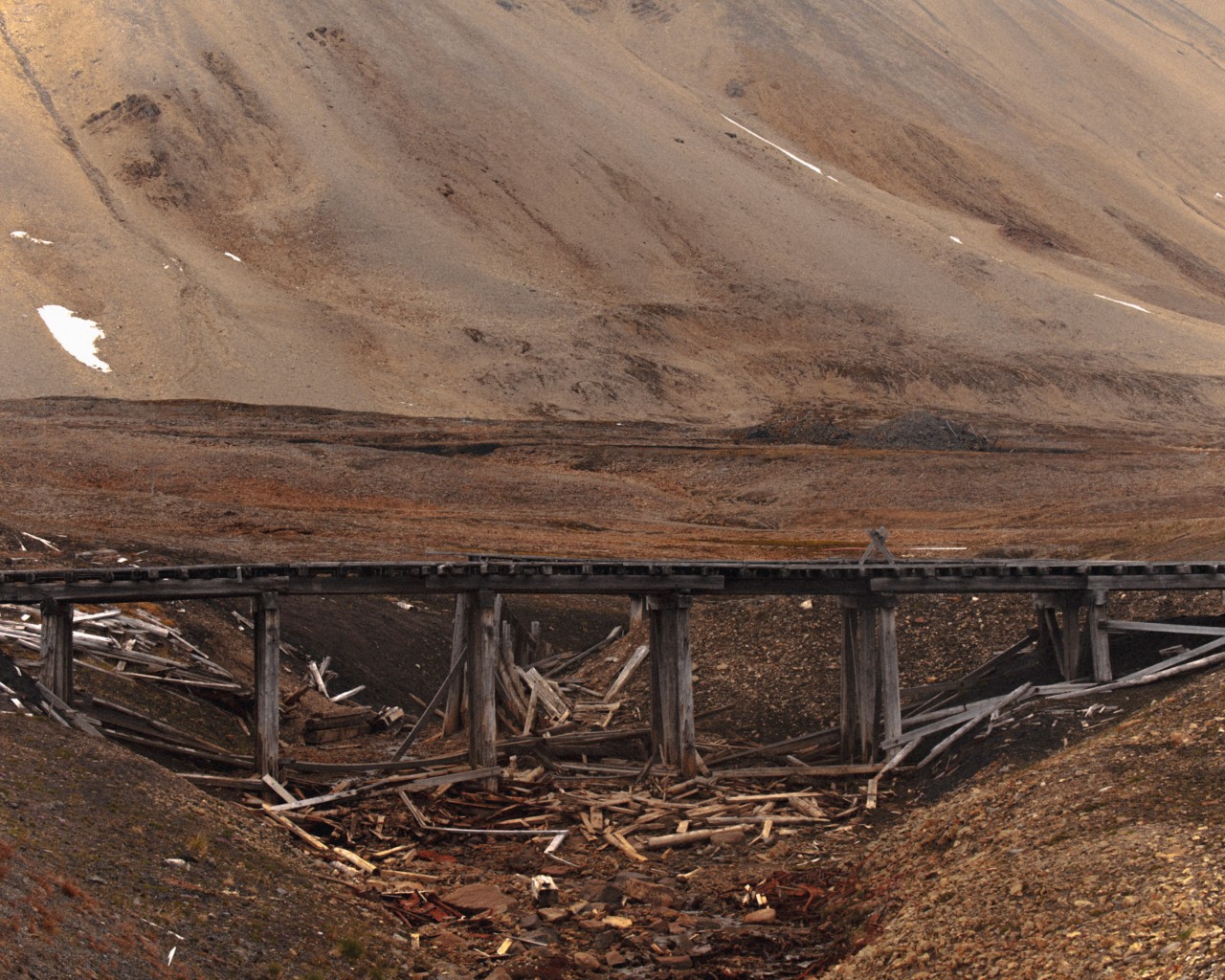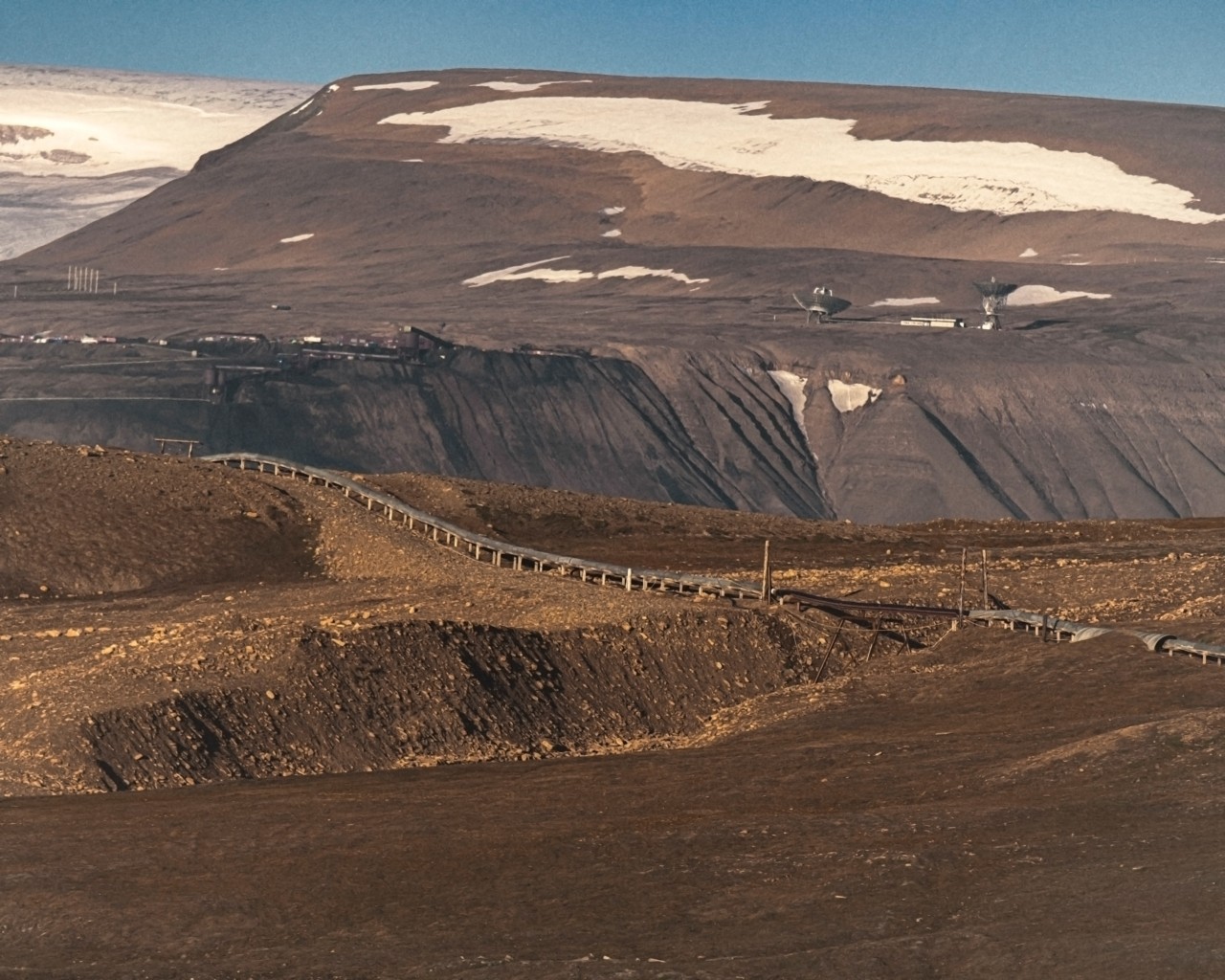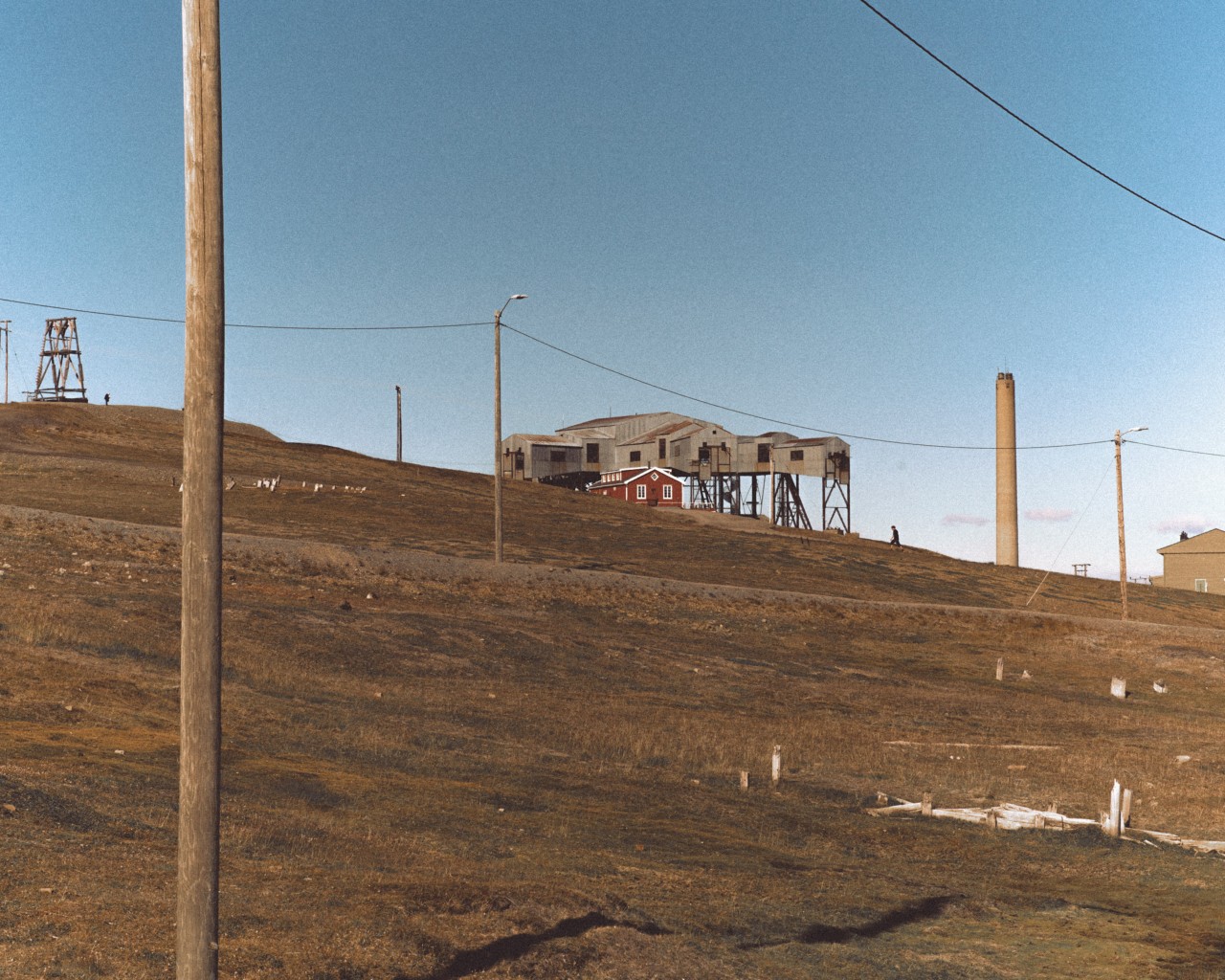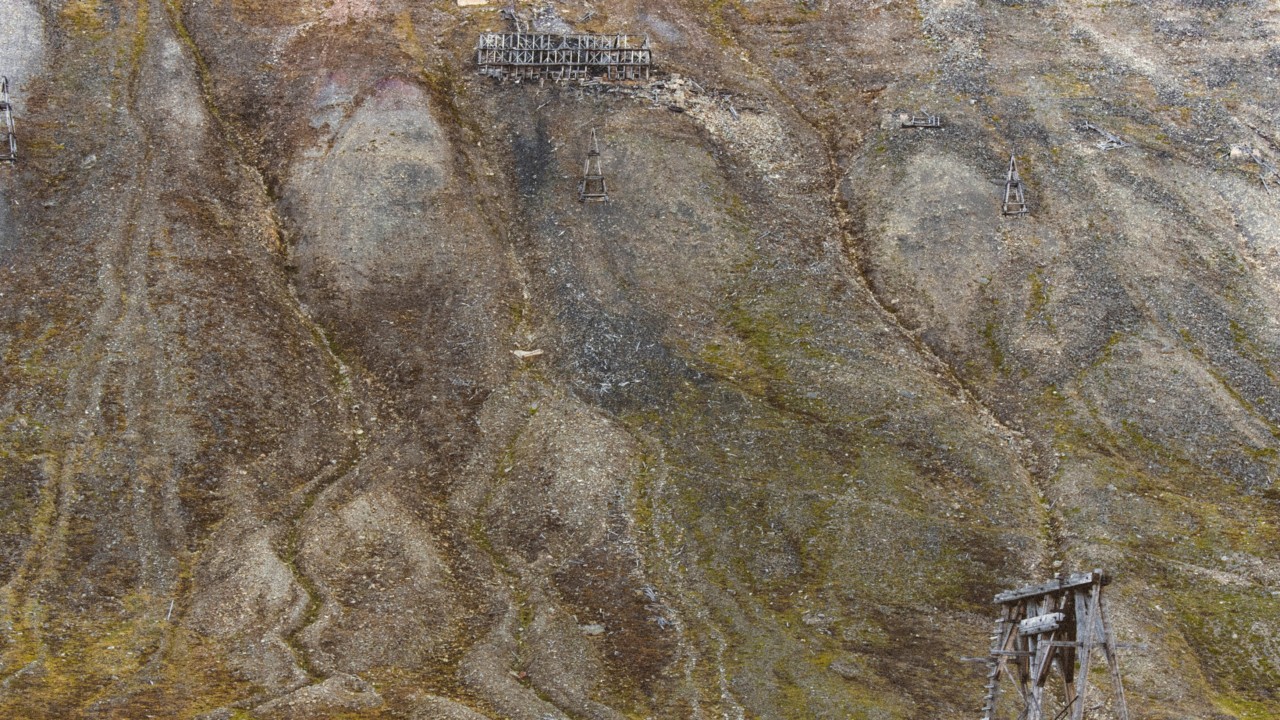
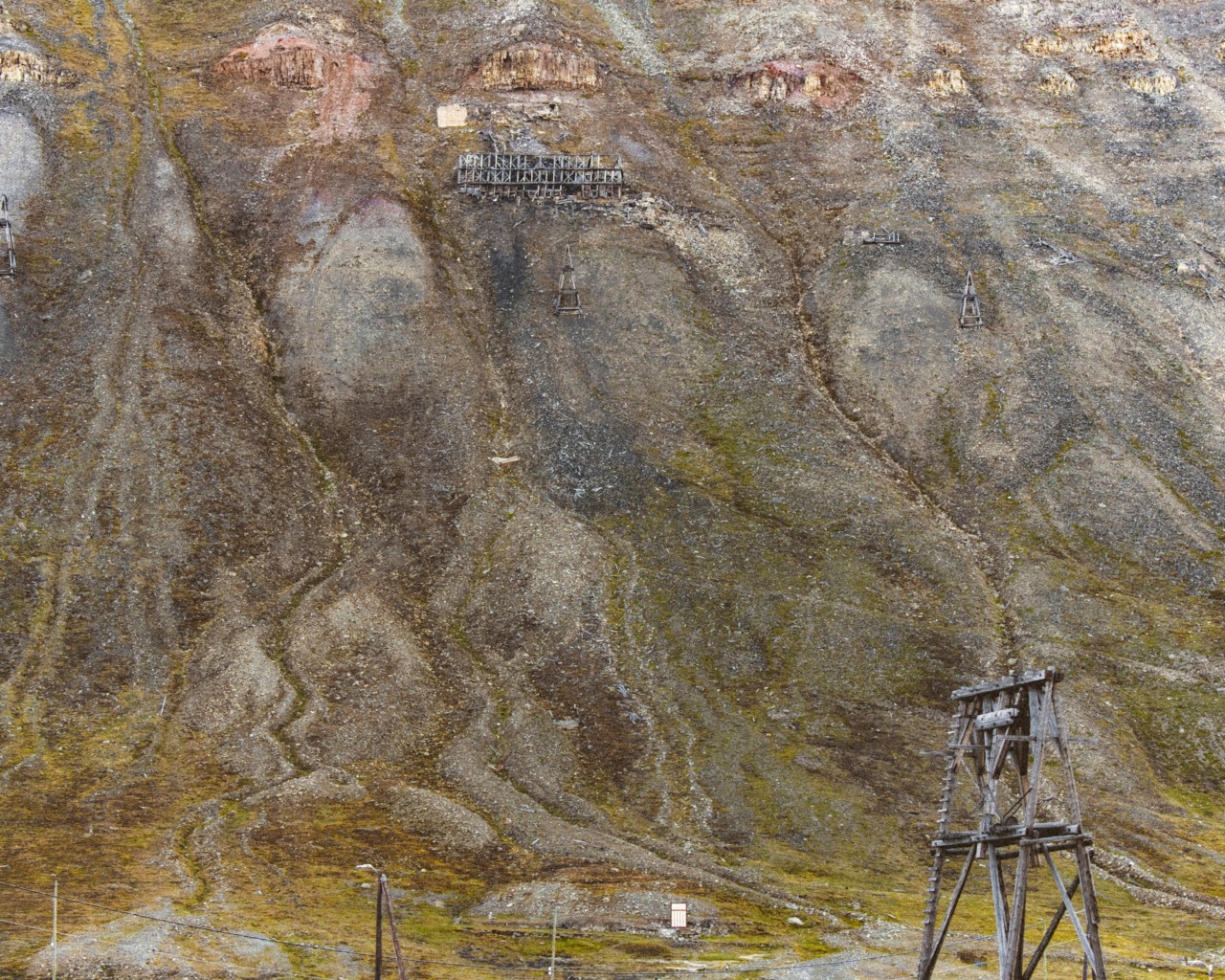
WORDS BY KIM KELLY
Svein Jonny Albrigtsen has been a coal miner for as long as he can remember. He and his family moved to Longyearbyen when he was 9 years old, back when it was a thriving mining settlement. The snowy, fjord-ringed town of 2,600 is still the largest community on the Svalbard archipelago, but much has changed since Albrigtsen began working at his first mine in 1985. He bounced around to multiple mines but has worked at Gruve 7 (Mine 7) for the past 24 years. “I have had all the jobs in the mine, but now I am head of the security,” he explained. “It’s good for me and my health also. I’m getting older.” In the summer of 2025, he’ll don his headlamp and perform his safety checks for the very last time. Gruve 7 is shutting down.
Longyearbyen (Longyear City) was founded by American industrialist John Munro Longyear, whose Arctic Coal Company operated mines throughout the archipelago from 1906 to 1916. Workers drawn by the promise of high wages flocked to Svalbard and set down roots, gradually transforming Longyearbyen from a rough Arctic miner’s camp into a thriving company town where coal powered the essentials—the lights, the heat, and the culture—and the coal company owned everything else. Though tourism and scientific research have since supplanted mining as the region’s primary industry, reminders of its past are everywhere, from public art installations in the city center honoring the miners who built Longyearbyen to the local custom of removing one’s shoes whenever you step inside a building (which began as a way to avoid tracking coal dust into one’s dwelling). Local legend has it that Santa Claus himself lives at the bottom of Gruve 2; each December, schoolchildren trek out to the foot of the mine to leave him their letters. “The town is built up around coal mining, over 100 years,” Albrigtsen said. That memory will be hard to shake, even as the city itself continues to evolve.
The Arctic Coal Company eventually sold its claims to the Store Norske Spitsbergen Kulkompani, a Norwegian state-owned coal company that still owns much of the land in and around Longyearbyen. SNSK now operates Gruve 7, Norway’s sole remaining coal mine on the archipelago, and oversaw the 2016 closure of Sveagruven (Swedish Mine). Sveagruven was once one of the largest underground coal mines in Europe, but was utterly transformed via a large-scale environmental restoration project led by Store Norske and supported by the Norwegian Ministry of Trade, Industry, and Fisheries. Buildings were torn down, heavy equipment was removed, and the area was painstakingly scrubbed of any sign of human activity. Now all that remains is a verdant field of Arctic grasses.
The Norwegian government hailed the Svea rewilding project as a major success and a firm example of its commitment to green environmental strategies. “We are committed to preserving as much as we can of the wilderness nature of Svalbard,” Norway’s former environment minister, Espen Barth Eide, told Euronews last year.

However, the reception from the local community was mixed. Albrigtsen, who worked at Sveagruven before its closing, characterized the project as “a bad decision” foisted upon Svalbard by government bureaucrats in Oslo. The Svea mine once employed 340 people. Now, Gruve 7 is down to about 50. “We have power, but, sometimes, we cannot reach them with the power,” he explained. “There are many people who don’t like coal mining. Coal mining is a bad word in the whole world now.”
Their predicament will ring familiar to Americans, particularly those who have seen firsthand what happens when mines shut down. For example, Appalachian states like West Virginia, Kentucky, and southern Virginia are still struggling to weather the impact of the coal industry’s decline. Centuries of extraction without proper community investment have left a gaping economic wound that has been exploited by political bad actors. For many former miners, losing the mines—and with them, the workers’ livelihoods—was a profoundly destabilizing event that rippled into the wider social and political landscape of the U.S.
When news broke that SNSK was planning to shut down Gruve 7, Albrigtsen and the other miners did their best to put up a fight. They staged a protest in the middle of town. “But they didn’t listen. They decided to close,” Albrigtsen said. He and about 40 of his coworkers are represented by the Norwegian Union of General Workers, which criticized the decision as short-sighted. Without a viable transition plan for Svalbard’s post-coal economy, and with shallow roots in the region unlike their Appalachian counterparts, most miners are likely to pack up and leave. The mine closure may be spun as environmental protection, but it really boils down to money and political power in the union’s view.
Without a viable transition plan for Svalbard’s post-coal economy, and with shallow roots in the region unlike their Appalachian counterparts, most miners are likely to pack up and leave.
“Of course, the environmental aspect of it was important,” Brede Edvardsen, vice chairman of the Norwegian Union of General Workers, told me. “But basically that was the right-wing government that made the decision. They didn’t make any money on the mine. That’s the real reason why.”
That focus on the bottom line misses the real value of the mine, though, Edvardsen added: “I think they are not aware of the role that the mining company, Store Norske, and therefore the Norwegian state, plays in a geopolitical context. The coal price has always been up and down for the last 100 years, and in the long run, we have never made money on it. That’s not the reason why they extracted the coal. It was to uphold our sovereignty.”
Gruve 7 was scheduled to close in 2023, but plans were delayed when war broke out between Russia and Ukraine. While Norway has sovereignty over Svalbard, providing it with bare-bones government services and infrastructure, and the majority of residents are Norwegian, they are not alone on the archipelago. The other major settlement, Barentsburg, is a Russian state-owned coal-mining community with roughly 500 Russian and Ukrainian residents; nearby, an abandoned Soviet-era coal camp, Pyramiden, has become a popular tourist attraction. Russia plans to slash Barentsburg mine’s production quota by two-thirds by 2032 and is working to increase tourism to the area. During an earlier era, relations between the two coal communities were cordial, if not toasty, and the shared border between Norway and Russia has generally seen both parties hold to at least a semblance of congeniality. “Norway has been able to hold our position in Svalbard because of the mining, because we are actually doing something there,” Edvardsen explained.

More recently, though, Russia has been testing those boundaries by targeting communications and government infrastructure. In 2022, a crucial undersea cable connecting Svalbard to mainland Norway was cut, allegedly by a Russian trawler. The following year, in December 2023, a Russian military rocket unexpectedly lit up the Svalbard sky. “Quite a few Westerners living in a dream were, like, ‘it’s the spirit of Saint Nicholas,’” one Longyearbyen resident grumbled. “Russia confirmed they had a test of rockets, which was flying over. Merry Christmas.”
As Russia’s war on Ukraine has escalated, so too have tensions between Norway and their Russian neighbors both on the mainland and on Svalbard. While Norway is shutting down its own coal mining program, the Russians have shown no signs of following suit, and the Norwegians I spoke to are anxious about the potential repercussions of surrendering their claim to the region’s soil. For the past century, Norway’s hold on Svalbard has been largely left unchallenged, but some fear that that may change once Russia controls its only active mine. “Everything they do in Barentsburg and Pyramiden is geopolitics, even if it’s tourism,” a local told me. “That’s also just to prove, first of all, to the Norwegians, and then to the West, and then to everyone else, that they are present in the Arctic.”
As the Arctic warms, geopolitical calculuses, maritime industries, military craft, and geography itself are shifting alongside the shrinking ice floes. Shipping lanes once blocked by Arctic sea ice are beginning to open up, creating potential new markets for Svalbard’s rich natural resources. As Albrigtsen notes, the Svalbard Treaty, the political framework that governs the archipelago, allows citizens of all signatory nations free access and the right to economic activities there. “Other countries can come after a few years and if they want to, they will start to mine,” Albrigtsen said darkly. “It will be political in the future. I think there will be more trouble.”
“Other countries can come after a few years and if they want to, they will start to mine. It will be political in the future. I think there will be more trouble.”
Mine closures are nearly always disruptive in some way—one need only look at the plight of former coal towns in Appalachia as evidence—but they seldom turn into the kind of geopolitical hot potato that Gruve 7 has become. As everyone I spoke with emphasized, the story is much bigger than 70 lost jobs in one small Arctic community, and the environmental impact of the shutdown seems to be the last thing on the minds of anyone involved. Albrigtsen and his coworkers have unwittingly become bit players in a global struggle over national sovereignty, natural resources, and land rights in an ecologically precious, increasingly politically significant region. To them, though, it feels much more personal. The Longyearbyen they knew is gone, and it’s not coming back.
Once the mine closes, Albrigtsen plans to retire and move to Oslo with his wife. Not every miner in Longyearbyen has such a cozy contingency plan. A dearth of employment opportunities in the region means that the only real option for most out-of-work miners in Svalbard will be to pack up and leave everything they know behind. “It’s a good work friendship between the miners, so I think they will feel in another world in a new job on the mainland,” Albrigtsen said. “It will not be the same.”
The heavy political gears now set in motion will crank on without them. It remains to be seen just how significant the loss of Gruve 7—and the Norwegian coal mining industry—will ultimately be to the nation’s security, economy, and environment, but for the people of Longyearbyen, it may as well be the end of the world.
“In the States, when the industry closed, people were out of jobs,” Edvardsen reminded me, linking the abandonment of America’s coal miners to the country’s current status as a political powder keg. West Virginia was once a Democratic stronghold thanks in part to its heavily unionized coal miners; now, in the most recent presidential election, 70% of voters went for Trump. “It was a lot of social unrest. You have Trump. That’s why there’s a connection here. The Trump voters, they’re not stupid. That’s not what it’s about. It’s about, OK, look at how things are going. We don’t have a job. People are desperate to do something about it. I get that. But we don’t want to get to that place.”

This story was co-published and supported by the journalism nonprofit the Economic Hardship Reporting Project.
The World’s Northernmost Coal Mine Closing Is Good News… Right?
